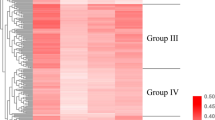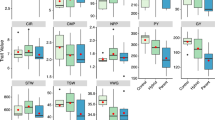Abstract
Half-sib (HS) mating is the most important breeding method of open-pollinated sexual forage grasses such as tall fescue. Progeny testing procedures of half-sib families can only measure general combining ability (GCA) due to the unknown pollen donor. In tall fescue, genetic studies using HS mating and application of molecular markers for paternity identification in polycross progenies are so far limited. In this study, 960 genotypes from sixteen half-sib families of tall fescue derived from polycrosses, along with their corresponding parental genotypes were evaluated for agro-morphological traits in the field during 2016 and 2017. Genetic diversity of the parental genotypes was assessed using twenty EST-SSR markers and then a minimal set of primers was used to identify the most likely male parent in the polycross progenies. Considerable genetic variation was observed among the parental genotypes based on both morphological and molecular assessments. Moderate to high estimates of narrow sense heritability (0.53–0.84) for morphological traits indicated that phenotypic selection can be successful to achieve genetic progress. The EST-SSR markers allowed to identify a unique paternal parent in 177 of the offspring which were divided into 66 full-sib families. The number of genotypes per full-sib family varied from 1 to 11. Marker data used to identify full-sib families, estimate specific combining ability (SCA), and select siblings based on the genetic value of both parents. No clear association was found between GCA of parents and the corresponding SCA for forage yield, indicating that both additive and dominant gene actions may play a role in the genetic control of this trait. The obtained results highlighted the importance of marker-based paternity identification to increase gain from selection in polycross breeding programs of tall fescue.


Similar content being viewed by others
References
Aastveit AH, Aastveit K (1990) Theory and application of open pollination and polycross in forage grass. Theor Appl Genet 79:618–624
Ahmad A, Wang JD, Pan YB, Sharif R, Gao SJ (2018) Development and use of simple sequence repeats (SSRs) markers for sugarcane breeding and genetic studies. Agron 8:1–19
Allen RG, Pereira LS, Raes D, Smith M (1998) Crop evapotranspiration: guidelines for computing crop requirements. FAO Irrig Drain Pap 56:41–51
Amini F, Mirlohi AF, Majidi MM (2011) Improved polycross breeding of tall fescue through marker-based parental selection. Plant Breed 130:701–707
Anderson JA, Churchill GA, Autrique JE, Tanksley SD, Sorrells ME (1993) Optimizing parental selection for genetic linkage maps. Genome 36:181–186
Araghi B, Barati M, Majidi MM, Mirlohi A (2014) Application of half-sib mating for genetic analysis of forage yield and related traits in Bromus inermis. Euphytica 196:25–34
Bowley SR, Christie RB (1981) Inheritance of dry matter yield in a heterozygous population of alfalfa. Can J Plant Sci 61:313–318
Buteler MI, LaBonte DR, Macchiavelli RE (1997) Determinig paternity in polyploids: hexaploid simulation studies. Euphytica 96:353–361
Buteler MI, LaBonte DR, Jarret RL, Macchiavelli RE (2002) Microsatellite-based paternity analysis in polyploid sweetpotato. J Am Soc Hortic Sci 127:392–396
Che YH, Li HJ, Yang YP, Yang XM (2008) On the use of SSR markers for the genetic characterization of the Agropyron cristatum (L.) Gaertn. In Northern China. Genet Resour Crop Evol 55:389–396
Cidade FW, Vigna Bianca BZ, Souza Francisco HD, Valls José Francisco M, Miguel Dall’Agnol, Zucchi Maria I, Souza-Chies TT, Souza Anete P (2013) Genetic variation in polyploid forage grass: assessing the molecular genetic variability in the Paspalum genus. BMC Genet 14:1–18
Cuyeu R, Rosso B, Pagano E, Soto G, Fox R, Daniel AN (2013) Genetic diversity in a world germplasm collection of tall fescue. Genet Mol Biol 6:237–242
Ebrahimiyan M, Majidi MM, Mirlohi A, Gheysari M (2012) Drought tolerance indices in a tall fescue population and its polycross progenies. Crop Pasture Sci 63:360–369
Ekiz HB, Konzak CF (1991) Nuclear and cytoplasmic control of anther culture response in wheat III Common wheat crosses. Crop Sci 31:1432–1436
Gazanchian A, Khoshkholghsima NA, Malboobi MA, Majidi-Heravan E (2006) Relationships between emergence and soil water content for perennial cool-season grasses native to Iran. Crop Sci 46:544–553
George RM, Jahufer MZZ, Barrett BA, Griffiths AG, Woodfield DR, Hofmann RW (2018) Application of molecular marker assayed paternity in a white clover breeding program. Crop Sci 58:1–13
Griffing B (1956) Concept of general and specific combining ability in relation to diallel crossing system. Aust J Biol Sci 9:463–493
Hand ML, Cogan NO, Forster JW (2012) Molecular characterization and interpretation of genetic diversity within globally distributed germplasm collections of tall fescue (Festuca arundinacea Schreb.) and meadow fescue (F. pratensis Huds.). Theor Appl Genet 124:1127–1137
Huang B, Gao H (2000) Root physiological characteristics association with drought resistance in tall fescue cultivars. Crop Sci 40:196–203
Jafari A, Naseri H (2007) Genetic variation and correlation among yield and quality traits in cocksfoot (Dactylis glomerata L.). J Agric Sci 145:599–610
Kearsey MJ, Pooni HS (1996) The genetical analysis of quantitative traits. Chapman and Hall, New York
Kolliker R, Boller B, Widmer F (2005) Marker assisted polycross breeding to increase diversity and yield in perennial ryegrass (Lolium perenne L.). Euphytica 146:55–65
Macherey N (2014) Genomic DNA from plant. User manual NucleoSpin Plant II protocols
Majidi MM, Mirlohi A, Amini F (2009) Genetic variation, heritability and correlations of agro-morphological traits in tall fescue (Festuca arundinacea Schreb). Euphytica 167:323–331
Mian MAR, Saha MC, Hopkins AA, Wang ZY (2005) Use of tall fescue EST-SSR markers in phylogenetic analysis of coolseason forage grasses. Genome 48:637–647
Mohammadi SA, Prasanna BM (2003) Analysis of genetic diversity in crop plants salient statistical tools and considerations. Crop Sci 43:1235–1248
Narasimhamoorthy B, Saha JH, Swaller T, Bouton JH (2008) Genetic diversity in switchgrass collections assessed by EST-SSR markers. Bioenergy Res 1:136–146
Nguyen HT, Sleper DA (1983) Theory and application of half sib mattings in forage grass breeding. Theor Appl Genet 64:187–196
Norton MR, Volaire F, Lelievre F (2006) Summer dormancy in Festuca arundinacea Schreb., the influence of season of sowing and a simulated mid-summer storm on two contrasting cultivars. Aust J Agric Res 57:1267–1277
Norton MR, Malinowski DP, Volaire F (2016) Plant drought survival under climate change and strategies to improve perennial grasses. Agron Sustain Dev 36:2–15
Pauly L, Flajoulot S, Garon J, Julier B, Beguier V, Barre P (2016) Quantitative trait loci (QTL) identification in the progeny of a polycross. Agron 51:1–13
Pirnajmedin F, Majidi MM, Gheysari M (2016) Survival and recovery of tall fescue genotypes: association with root characteristics and drought tolerance. Grass Forage Sci 71:632–640
Pirnajmedin F, Majidi MM, Saeidi G, Gheysari M, Volaire F, Barre P, Osivand AH, Sarfaraz D (2017) Persistence, recovery and root traits of tall fescue genotypes with different flowering date under prolonged water stress. Euphytica 213:269
Posselt UK (2010) Breeding method in cross-pollinated species. In: Boller B, Posselt UK, Veronesi F (eds) Fodder crops and amenity grasses, handbook of plant breeding, vol 5. Springer, New York, pp 39–87
Powell W, Morgante M, Andre C, Vogel J, Tingey S, Rafalski A (1996) The comparison of RFLP, RAPD, AFLP and SSR (microsattlite) markers for germplasm analysis. Mol Breed 2:225–238
Prevost A, Wilkinson MJ (1999) A new system of comparing PCR primers applied to ISSR fingerprinting of potato cultivars. Theor Appl Genet 98:107–112
Riday H (2011) Paternity testing: a non-linkage based marker-assisted selection scheme for outbred forage species. Crop Sci 51:631–641
Riday H, Johnson DW, Heyduk K, Raasch JA, Darling ME, Sandman JM (2013) Paternity testing in an autotetraploid alfalfa breeding polycross. Euphytica 194:335–349
Rohlf FJ (2009) NTSYS-pc: numerical taxonomy and multivariate analysis system. Version 2.2. Exeter software, Setauket, New York
Saha MC, Mian MAR, Eujayl I, Zwonitzer JC, Wang L, May GD (2004) Tall fescue EST-SSR markers with transferability across several grass species. Theor Appl Genet 109:783–791
SAS Institute (2001) User,s guide. Release 9.2 SAS Institute, Cary N. C. Nos SAS and SSSA, Madison, W, pp 225–293
Seal AG (1983) DNA variation in Festuca. Heredity 50:225–236
Shahabzadeh Z, Mohammadi R, Darvishzadeh R, Jaffari M (2019) Genetic structure and diversity analysis of tall fescue populations by EST-SSR and ISSR markers. Mol Biol Rep 47:655–669
Shaimi N, Kallida R, Volaire F, Saidi N, Faiz CA (2009) Summer dormancy and drought survival of moroccan ecotypes of orchardgrass. Crop Sci 49:1416–1424
Sleper DA (1987) Forage grasses. In: Fehr WR (ed) Principles of cultivar development crop species, vol 2. Macmillian Publishing Co., New York, pp 161–208
Sun J, Hongji L, Jinmin F, Huang B (2013) Classification of genetic variation for drought tolerance in tall fescue using physiological traits and molecular markers. Crop Sci 53:647–654
Wricke G, Weber WE (1986) Quantitative genetics and selection in plant breeding. Walter de Gruyter, New York
Xavier MA, Pinto LR, Favero TM, Perecin D, Carlini-Garcia LA, Landell MGA (2014) Paternity identification in sugarcane polycrosses by using microsatellite markers. Genet Mol Res 13:2268–2277
Acknowledgements
The authors would like to thank National Elite Foundation and Isfahan University of Technology (IUT) to support this work. The authors also would like to thank the Gundishapur EGIDE scheme (Iran–France collaboration).
Author information
Authors and Affiliations
Corresponding author
Additional information
Publisher's Note
Springer Nature remains neutral with regard to jurisdictional claims in published maps and institutional affiliations.
Electronic supplementary material
Below is the link to the electronic supplementary material.
Rights and permissions
About this article
Cite this article
Pirnajmedin, F., Majidi, M.M., Barre, P. et al. Enhanced polycross breeding of tall fescue through marker-based paternity identification and estimation of combining ability. Euphytica 216, 139 (2020). https://doi.org/10.1007/s10681-020-02671-1
Received:
Accepted:
Published:
DOI: https://doi.org/10.1007/s10681-020-02671-1




